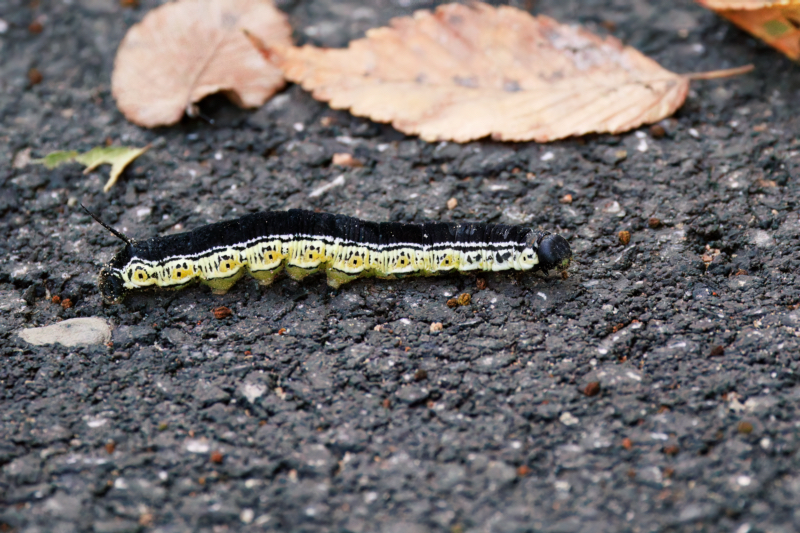Earlier this week, I had a chance encounter with a Catalpa Sphinx Caterpillar making its way across a road near the Ouachita National Forest here in Arkansas. It was a striking sight—this little creature boldly crossing the road, completely unaware of how special it was to spot one in action. For those who aren’t familiar with the Catalpa Sphinx Caterpillar, or “Catawba worm” as it’s often called, this insect has quite the story behind it.
The Catalpa Sphinx Caterpillar: Nature’s Leaf Eater
Catalpa Sphinx Caterpillars, in their larval stage, are known for their distinctive appearance and insatiable appetite. They begin life as small, white caterpillars with black spots but eventually develop into a golden-yellow color with a bold black stripe running down their back and black dots on either side. This striking coloration makes them easy to spot, especially as they chomp away on catalpa tree leaves, their main (and only) food source. These caterpillars are voracious eaters and can defoliate entire catalpa trees if the population is large enough. You might think that sounds bad for the trees, but not to worry—the catalpa trees have adapted to this relationship. They can regrow their leaves quickly after being feasted upon, ensuring both the tree and the caterpillars survive in harmony.
Where to Find the Catalpa Sphinx Caterpillar
If you’re looking to see one of these remarkable caterpillars yourself, Arkansas is a great place to start. They’re commonly found in forests, parks, and gardens, especially where catalpa trees are present. The Catalpa Sphinx Caterpillar is most commonly spotted in the eastern half of the U.S., including here in Arkansas. And as the name suggests, they’re often munching away on the leaves of catalpa trees—so that’s your best bet for finding one.
From Caterpillar to Moth: A Fascinating Life Cycle
One of the most remarkable things about the Catalpa Sphinx Caterpillar is its life cycle. After hatching from their eggs, the caterpillars spend a few weeks devouring catalpa leaves to build up strength. Once they’ve grown large enough, they pupate, spinning a cocoon where they’ll undergo a complete transformation into an adult moth. The adult Catalpa Sphinx Moth is an impressive sight, with a wingspan that can reach up to 4 inches. Though they’re nocturnal and usually fly at night, you might spot one resting during the day, attracted by artificial lights. The moths live only for a few days, and during that brief time, their main goal is to mate and lay eggs, ensuring the next generation of caterpillars continues the cycle.
Why the Catalpa Sphinx Caterpillar Matters
Beyond just being an interesting creature to observe, the Catalpa Sphinx Caterpillar plays an important role in the ecosystem. By feeding on the catalpa trees, they help keep the trees in balance, preventing overgrowth. And, in turn, the caterpillars themselves become food for a variety of wildlife, including birds and other predators. This intricate relationship between the caterpillar, the catalpa tree, and the surrounding wildlife highlights the beauty and complexity of nature.
Observing the Catalpa Sphinx Caterpillar in Arkansas
If you’re ever out exploring near catalpa trees or taking a stroll through the woods in Arkansas, keep an eye out for these incredible caterpillars. Whether it’s their bold colors or the way they completely defoliate a tree, they’re sure to catch your attention. And if you’re lucky enough to spot an adult Catalpa Sphinx Moth, take a moment to appreciate how this creature represents nature’s power of transformation—from a tiny caterpillar to a beautiful, fleeting moth.
Witnessing the Catalpa Sphinx Caterpillar firsthand is a reminder of the intricate cycles of life happening all around us. It’s these moments in nature that make wildlife photography—and simply being outside—so rewarding.
